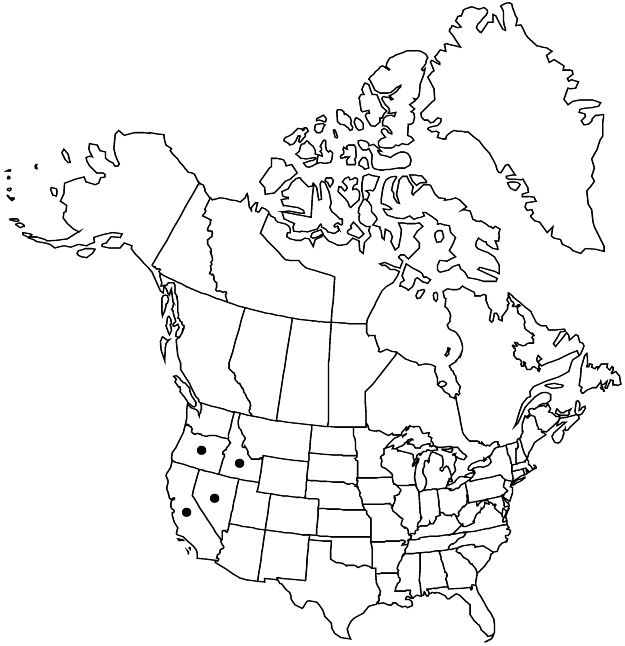Difference between revisions of "Ivesia gordonii var. ursinorum"
Novon 17: 323. 2007.
FNA>Volume Importer |
imported>Volume Importer |
||
| (5 intermediate revisions by 2 users not shown) | |||
| Line 12: | Line 12: | ||
|label=Endemic | |label=Endemic | ||
}} | }} | ||
| − | |basionyms={{Treatment/ID/ | + | |basionyms={{Treatment/ID/Basionym |
|name=Potentilla gordonii var. ursinorum | |name=Potentilla gordonii var. ursinorum | ||
|authority=Jepson | |authority=Jepson | ||
| + | |rank=variety | ||
| + | |publication_title=Man. Fl. Pl. Calif., | ||
| + | |publication_place=492. 1925 | ||
}} | }} | ||
|synonyms= | |synonyms= | ||
| Line 41: | Line 44: | ||
-->{{#Taxon: | -->{{#Taxon: | ||
name=Ivesia gordonii var. ursinorum | name=Ivesia gordonii var. ursinorum | ||
| − | |||
|authority=(Jepson) Ertter & Reveal | |authority=(Jepson) Ertter & Reveal | ||
|rank=variety | |rank=variety | ||
| Line 56: | Line 58: | ||
|publication year=2007 | |publication year=2007 | ||
|special status=Endemic | |special status=Endemic | ||
| − | |source xml=https:// | + | |source xml=https://bitbucket.org/aafc-mbb/fna-data-curation/src/2e0870ddd59836b60bcf96646a41e87ea5a5943a/coarse_grained_fna_xml/V9/V9_360.xml |
|subfamily=Rosaceae subfam. Rosoideae | |subfamily=Rosaceae subfam. Rosoideae | ||
|tribe=Rosaceae tribe Potentilleae | |tribe=Rosaceae tribe Potentilleae | ||
Latest revision as of 22:56, 5 November 2020
Stems usually dark reddish, usually prostrate to ascending, rarely nearly erect, (0.2–)0.5–1.5(–2.5) dm, usually not villous or hirsute, minutely glandular or glandular-puberulent to -pubescent. Basal leaves (1–)3–8(–15) × 0.3–0.8 cm; leaflets 1–4(–6) mm, glabrous or sparsely hirsute, at least marginally, rarely more densely hirsute. Inflorescences 5–20(–25)-flowered, usually simple, 1–2(–5) cm diam., glomerules usually 1, capitate to loosely congested. Flowers 6–9 mm diam.; epicalyx bractlets (0.5–)1.5–2(–3) mm; hypanthium (1.5–)2–3(–4) × 2–3(–4) mm; sepals (2–)2.5–4(–4.5) mm, acute; anthers usually red-margined.
Phenology: Flowering summer.
Habitat: Rocky slopes and outcrops, in high-elevation sagebrush communities, montane conifer woodlands
Elevation: 1800–3500 m
Distribution

Calif., Idaho, Nev., Oreg.
Discussion
As circumscribed here, var. ursinorum encompasses “tenuicaulis” of N. H. Holmgren (1997b) but is more broadly defined to encompass generally prostrate to decumbent plants found at widely scattered locations in and adjacent to the northwestern Intermountain Region. Such plants are most common in the Independence and Jarbidge mountains (Elko County, Nevada) and on Steens Mountain and other ranges in southeastern Oregon. Similar plants dominate the mountains of central Idaho and the Wallowa Mountains of Oregon, mostly south of var. alpicola. In northern California, var. ursinorum is found on the Modoc, Scott, and Sweetwater mountains, and around Sonora Pass in the Sierra Nevada.
In general, var. ursinorum may be distinguished from var. alpicola by its more commonly prostrate to ascending habit, reddish stems, narrowly cylindric (bottlebrushlike) leaves, and rounder leaflet lobes. The inflorescence is also more prone to becoming lax at maturity. Plants are most often glandular-pubescent and minutely glandular but otherwise glabrate, the conspicuous exception being the type of var. ursinorum from northern California. Plants in the Wallowa Mountains approach var. alpicola, as do some populations in California and central Idaho, where they are sometimes only tentatively assigned to one variety or the other. Some central Idaho collections included here in var. ursinorum have more cupulate hypanthia and wider petals approaching those of Ivesia lycopodioides.
Selected References
None.